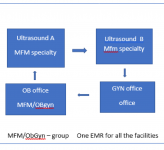RABBIT2020
Networker

This is a group practice with Obgyn and Maternal Fetal Medicine subspeciality.
Patients are scheduled among the 4 office locations depending on their medical needs.
The doctors circulate among the 4 locations
There is one central EMR with patients database.
Each facility has its own identifying tax id.
Questions:
1. Patient goes to Ultrasound A has a face to face with a MFM specialist for a consult. The following week the patient goes to OB office for an outpatient problem visit with an
obgyn. Is the patient new or established to the obgyn? Why?
2. The Patient is seen at the Gyn office for a procedure by a gyn doctor. She subsequently goes to the Ultrasound site for a scan. A MFM specialist consult (face to face) with her due to an abnormal finding on the scan. Is the patient new or established to the MFM specialist?
3. A patient has ob procedure (amniocentesis) at the ultrasound facility by the MFM specialist. Two weeks later the MFM specialist sees the same patient for a Gestational diabetes at the OB office? Is the service at the ob office billed as a New patient or established patient visit. (consultation is billed with office visit cpt)
3. Just because these offices are at separate locations and have their own separate tax id are they to be considered separate entities?